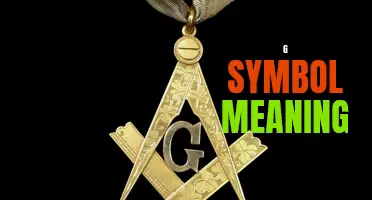
The red rose has long been revered as the ultimate symbol of love and passion, capturing the hearts of countless admirers throughout history. With its vibrant crimson hue and velvety petals, this stunning flower has come to represent the intensity of desire and the beauty of romantic love. From Shakespeare's iconic love sonnets to modern-day gestures of affection, the red rose has transcended time and culture, serving as a universal symbol of devotion and desire. In this article, we will delve into the rich symbolism behind the red rose and explore its fascinating meaning throughout different eras and traditions.
What You'll Learn
- What is the symbolism behind a red rose?
- How has the meaning of the red rose changed throughout history?
- What cultures or societies associate specific meanings with red roses?
- Are there any specific occasions or events where red roses are commonly used as a symbol?
- How does the meaning of a red rose compare to that of other colors of roses?

What is the symbolism behind a red rose?
A red rose is one of the most iconic symbols in human culture. It is often used to convey love, beauty, and passion. The color red in itself is associated with strong emotions and intense feelings, making it a perfect choice for expressing love.
The symbolism behind a red rose can be traced back to ancient times. In Greek mythology, it is said that the red rose was created by the goddess Aphrodite, the goddess of love and beauty. According to one legend, when Aphrodite's lover Adonis was mortally wounded, she rushed to his side and pricked her foot on a thorn, turning the white roses red with her blood. From that moment on, the red rose became a symbol of love and devotion.
In Christian symbolism, the red rose is often associated with the Virgin Mary and represents her purity and love. It is also used to symbolize the blood of Christ and his sacrifice.
In literature and poetry, the red rose is frequently used as a symbol of love and passion. It is often described as the most beautiful and romantic flower, evoking feelings of deep affection and desire. Shakespeare famously wrote, "What's in a name? That which we call a rose by any other name would smell as sweet."
In modern culture, the symbolism of the red rose is still very much alive. It is a common sight on Valentine's Day, where it is given as a gift to express romantic love. The red rose is also used in weddings, symbolizing the love and commitment between the bride and groom.
Overall, the symbolism behind a red rose is rich and deep-rooted in human culture. It represents love, beauty, and passion, making it the perfect symbol to convey strong emotions. Whether given as a gift or used in art and literature, the red rose continues to captivate and inspire people all over the world.
The Fascinating Symbolism Behind the 'T' Symbol
You may want to see also

How has the meaning of the red rose changed throughout history?
Throughout history, the red rose has held a significant meaning and symbolized various emotions and events. This iconic flower has a rich history that dates back thousands of years and has gradually evolved in meaning and significance. From ancient civilizations to modern times, the red rose has played a significant role in different cultures and has been associated with love, passion, war, and more.
In ancient civilizations such as Egypt, Greece, and Rome, the red rose was closely linked to the goddess of love and beauty. It represented love, desire, and fertility. In Greek mythology, the red rose was associated with Aphrodite, the goddess of love, who was often depicted surrounded by roses. The Romans, too, embraced the red rose as a symbol of love and desire, and it became popular during their elaborate festivals and celebrations.
During the Middle Ages, the red rose gained additional significance through the influence of Christianity. The red rose began to represent the Virgin Mary, with its petals symbolizing her purity and the blood of Christ. This religious association led to the red rose becoming a symbol of martyrdom and sacrifice during the Crusades.
In the 18th century, the red rose's meaning shifted towards a more romantic sentiment. Love and passion became closely associated with the red rose, and it became a popular choice for lovers and poets. The red rose's representation of deep and passionate love flourished during this era and has remained a dominant meaning to this day.
In modern times, the red rose has become synonymous with Valentine's Day. It is the ultimate symbol of love and is often exchanged as a token of affection and devotion. This association with love has made the red rose an almost universal symbol of romantic feelings and is often used to express love, desire, and admiration.
However, it is important to note that the red rose can also have different meanings depending on the cultural context. In some cultures, it may represent bravery, courage, or even death, while in others, it may signify prosperity or good luck. These cultural variations demonstrate the fluidity and adaptability of the red rose's meaning throughout history.
In conclusion, the red rose has undergone significant changes in meaning throughout history. From its early associations with love and fertility in ancient civilizations to its religious symbolism during the Middle Ages and its romantic connotations in modern times, the red rose has symbolized various emotions and events. While it remains a powerful symbol of love and passion in current times, its associations with other cultural meanings remind us of the complexity and richness of this iconic flower's history.
The Hidden Symbolism Behind the Mercedes Benz Logo Revealed
You may want to see also

What cultures or societies associate specific meanings with red roses?
In many cultures and societies around the world, the vibrant red rose holds significant symbolic meaning. This elegant flower is often associated with love, passion, and romance, making it a popular choice for special occasions such as Valentine's Day, anniversaries, and weddings. However, the meaning behind red roses can vary across different cultures and societies. Let's explore some of these associations.
In Western culture, the red rose is a universal symbol of love and romance. It is widely recognized as a way to express deep affection and desire for someone. This association can be traced back to ancient Greek and Roman mythology, where the red rose was connected to the goddess of love, Aphrodite (Greek) or Venus (Roman). Thus, presenting someone with a bouquet of red roses is considered a romantic gesture and often signifies true love and passion.
In Chinese culture, red is a color that symbolizes luck, prosperity, and happiness. Therefore, the red rose is often used to celebrate joyous occasions such as weddings and Chinese New Year. It is also associated with the concept of yin and yang, representing the balance between love and beauty.
In Persian culture, the red rose holds deep symbolism and is often referred to as the "flower of love." It is considered a representation of beauty, purity, and eternal love. The Persian poet Sadi compared the beauty of a red rose to the beauty of a lover's lips, emphasizing the connection between the flower and romantic love.
In Hindu culture, the red rose is associated with the goddess of beauty and love, Radha. It represents love, passion, and devotion, and is often used in religious ceremonies and rituals. In addition, the red rose is also considered to be a symbol of divine love and devotion towards Lord Krishna.
In Islamic culture, the red rose is a symbol of paradise and reward. It is believed that in heaven, believers will be rewarded with beautiful gardens filled with red roses. Therefore, the red rose is often used in Islamic art and is seen as a symbol of hope and eternal happiness.
Overall, the red rose is a flower that holds deep cultural and symbolic meaning in various societies. Whether it represents love, luck, or beauty, the red rose has become a universal symbol of emotion and is cherished by people across the globe. Whether you are expressing your love to a partner, celebrating a joyous occasion, or seeking spiritual meaning, the red rose remains an enduring symbol of affection and desire.
The Importance of Packaging Symbols and Their Meaning
You may want to see also

Are there any specific occasions or events where red roses are commonly used as a symbol?
Red roses are one of the most iconic symbols of love and romance. Their vibrant red color and delicate petals have been used to express deep emotions for centuries. While red roses are a popular choice for many occasions, there are a few specific events where they are commonly used as a symbol.
Valentine's Day is perhaps the most well-known occasion where red roses are exchanged as a token of love. This holiday, celebrated on February 14th, is all about expressing love and affection to your significant other. Red roses are the perfect choice for this occasion as they symbolize passionate love and desire. Many people choose to give a bouquet of red roses to their partner on Valentine's Day to show their love and devotion.
Another common event where red roses are used as a symbol is weddings. Red roses can represent a deep love and commitment between two people, making them an ideal choice for this special day. Many couples choose to incorporate red roses into their wedding decor, bouquets, and centerpieces to add a touch of romance and elegance to their celebration. Red roses can also be given to the bride or groom as a symbol of their everlasting love.
Anniversaries are another occasion where red roses are commonly used. Whether it's a first anniversary or a milestone celebration, red roses can be given as a romantic gesture to celebrate the love and commitment between two people. Many couples choose to give a dozen red roses to each other on their anniversary as a symbol of their enduring love and devotion.
Lastly, red roses can also be used as a symbol of apology. If someone has done something wrong and wants to make amends, a bouquet of red roses can be a thoughtful gesture to show remorse and sincerity. The vibrant red color of the roses can convey a heartfelt apology and the desire to make things right.
In conclusion, red roses are commonly used as a symbol of love and affection on a variety of occasions. Whether it's Valentine's Day, a wedding, an anniversary, or as a gesture of apology, red roses can convey deep emotions and sentiments. Their beauty and symbolism make them a timeless choice for expressing love and romance.
The Mysterious Symbolism Behind Ghostemane's Enigmatic Persona
You may want to see also

How does the meaning of a red rose compare to that of other colors of roses?
The rose is a timeless symbol of love and beauty, but did you know that the color of a rose can also carry its own special meaning? While every color of rose is undeniably elegant and stunning in its own right, each hue has its own unique significance and message to convey. In this article, we will explore the meaning of a red rose in comparison to other colors of roses.
When you think of a rose, the first color that likely comes to mind is red. Red roses have long been associated with love, passion, and romance. They are a classic and timeless symbol of deep affection and desire. The intensity of the color red represents the strong emotions and fiery love that is often expressed with these beautiful flowers. Red roses are often gifted on Valentine's Day, anniversaries, and special occasions to convey love and devotion.
On the other hand, white roses represent purity, innocence, and new beginnings. They are often used in weddings and can also signify sympathy and spirituality. White roses are often associated with peace and can be given as a gesture of goodwill or to express condolences.
Pink roses are a symbol of grace, gratitude, and admiration. They convey a sense of appreciation and thanks and can be given to show admiration or as a symbol of friendship. Light pink roses have a delicate and romantic meaning, while dark pink roses represent gratitude and appreciation.
Yellow roses have a sunny and cheerful disposition. They are often associated with friendship, joy, and happiness. Yellow roses can be used to brighten someone's day or to congratulate them on a special achievement.
Orange roses are a symbol of enthusiasm and passion. They can be given to show admiration or to express excitement or desire. Orange roses are vibrant and energetic, making them a great choice to bring a burst of positive energy to any occasion.
Lastly, lavender or lilac roses hold a romantic and enchanting meaning. They are often associated with love at first sight and can convey a sense of enchantment and fascination. These roses can be given to express affection and admiration for someone special.
While the meaning of a red rose is often associated with love and romance, other colors of roses offer their own unique interpretations. Whether you choose to gift a red rose to express your deep love or a yellow rose to celebrate a friendship, each color holds its own special symbolism. The beauty of roses lies not only in their stunning appearance but also in the messages they carry. So the next time you want to express your feelings, consider the color of the rose you choose, as it can add an extra layer of sentiment to your heartfelt gesture.
Unveiling the Magical World of Wizard Symbols: Their Fascinating Meanings and Power
You may want to see also
Frequently asked questions
A red rose is the ultimate symbol of love and romance. It represents passion, desire, and deep affection. It is often given as a gift to express love on special occasions like Valentine's Day or anniversaries.
Yes, besides love and romance, a red rose can also symbolize beauty, courage, and respect. It is seen as a powerful and bold flower that conveys strong emotions and admiration.
Yes, the red rose has a long history of cultural significance. In many cultures, it is associated with passion and love. In Victorian times, giving someone a red rose was a secret way of saying "I love you." In Christianity, the red rose is often associated with the Virgin Mary and represents purity and martyrdom.
While the red rose is primarily associated with romantic love, it can also symbolize deep friendship and strong bonds. Giving a red rose to a friend can convey admiration, loyalty, and gratitude for their friendship.
Yes, different colors of roses can have varying meanings. For example, a yellow rose symbolizes friendship and joy, while a white rose represents innocence and purity. Pink roses can symbolize gratitude and appreciation, while orange roses are often associated with enthusiasm and desire. Each color of rose has its own unique symbolism and can be used to convey different emotions.







